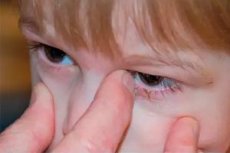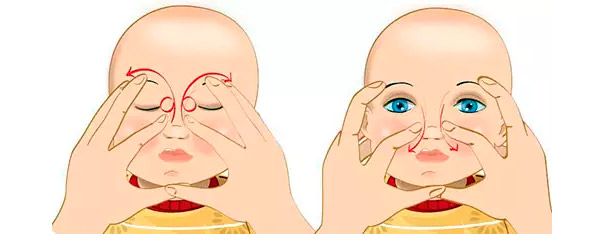Medical expert of the article
New publications
Tear duct and gland massage in infants and adults
Last reviewed: 06.07.2025

All iLive content is medically reviewed or fact checked to ensure as much factual accuracy as possible.
We have strict sourcing guidelines and only link to reputable media sites, academic research institutions and, whenever possible, medically peer reviewed studies. Note that the numbers in parentheses ([1], [2], etc.) are clickable links to these studies.
If you feel that any of our content is inaccurate, out-of-date, or otherwise questionable, please select it and press Ctrl + Enter.

The production of tears is a continuous process in the body and is carried out by the lacrimal glands. Spreading evenly across the cornea of the eye, tears through thin lacrimal canals enter a special reservoir - the lacrimal sac, after which they are discharged through thin ducts connecting the nose and eyes. The need for a massage of the lacrimal canal and lacrimal glands occurs when the lacrimal canal becomes blocked, as a result of which tears accumulate in the sac, press on it, leading to its inflammation and infection.
 [ 1 ]
[ 1 ]
Indications for the procedure
Indications for performing a lacrimal canal massage are severe lacrimation, accumulation of yellow fluid in the corners of the eyes, sticking together of the eyelids, their redness, swelling of the eyes and the area around them. Most often, massage of the lacrimal canal is used in newborns, since on average 5-6 babies out of 100 have a blockage of the lacrimal canal. The reason for this is the duct outlet closed by embryonic tissue, which should open itself during childbirth, and the film should break. Only an ophthalmologist can diagnose this pathology, who will conduct an examination and confirm the diagnosis using a special test. The so-called West test involves dripping a contrast agent into the eye, and inserting a cotton swab into the nose. If the patency is not impaired, it will be colored. There are also methods for determining the location of the blockage. Initially, a massage is prescribed to eliminate the pathology, which parents should do regularly at home. Massage movements create pressure in the nasal duct, which can rupture the membrane and restore the patency of the lacrimal ducts.
Massage is also indicated for dacryocystitis caused by narrowing of the tear ducts as a result of inflammation of the nasal cavity. In this case, massage accelerates the outflow of purulent masses and stimulates the work of the lacrimal glands. In combination with it, eye rinsing with anti-inflammatory and antiseptic drugs is performed.
Obstruction in adults is rare, but it happens in older people, because the elasticity of tissues decreases with age, muscles weaken. Injuries, neoplasms, thickening of the layer inside the duct can cause obstruction of the canal. Unfortunately, massage of the lacrimal canals in adults does not lead to a solution to the problem. It will require rinsing with disinfectants, and if ineffective, resort to surgical intervention. But massage of the eyeballs, the area around the eyes, soft tissues of the face is indicated for glaucoma, inflammation of the mucous membrane of the eyelids and eyes, myopia, eye fatigue, paresis, traumatic cataracts, myopia. And yet, with dacryocystitis, massage of the lacrimal canal is carried out as a complex therapy.
Preparation
Preparation for the massage consists of disinfecting the hands and preparing the massage points. To do this, you need to wash your hands thoroughly, cut your nails so as not to scratch the child's face. Then soak a cotton swab in chamomile decoction or furacilin solution and wipe the eye slit from the outer edge to the inner, removing purulent discharge, if any.
Technique lacrimal massage
The massage is performed with the index fingers of both hands. The technique is that there are bumps on the eyes near the bridge of the nose that need to be felt and pressed briefly, moving downwards towards the nose, trying to push the liquid into the nasal cavity.

These movements should not be stroking, they should be repeated at least 10 times without stopping. When pressing on the tear sacs, pus may flow out, which should be removed with the solution used before the massage. You cannot wipe twice with the same swab. Success can be achieved by performing manipulations at least 4-7 times a week, for at least 2 weeks. Most often, the tear ducts open by the end of the third month of the child's life.
Contraindications to the procedure
Contraindications to massage of the lacrimal canal and lacrimal glands are oncological neoplasms, injuries with perforation, purulent processes, including phlegmon of the lacrimal sac or, as it is also called, acute purulent peridacryocystitis. Massage cannot be performed in case of hydrops (dropsy) of the lacrimal sac.
Consequences after the procedure
The consequences of the procedure of lacrimal canal massage are usually positive. At first, the discharge of pus may increase, but this only indicates that the massage is being performed correctly. If the procedure does not lead to the expected result, they resort to probing the nasolacrimal canal.
Complications after the procedure
After a two-week massage and no results, it should be stopped, as complications after the procedure are possible. The surrounding tissues may be involved in the inflammatory process, which will lead to serious pathologies of the visual organ. Phlegmon of the lacrimal sac is dangerous. It manifests itself not only by its redness and swelling of the sac, but also by high temperature, increased leukocytes and ESR in the blood. In an unfavorable course, phlegmon opens not outward, but into the eye socket. Such a development is dangerous because fistulas may form, and the cranial cavity is nearby. Infection of the brain can lead to complete loss of vision, disruptions in the central nervous system, and memory loss.
 [ 10 ]
[ 10 ]
Care after the procedure
Post-massage care includes instilling eye drops with anti-inflammatory eye drops. Most often, Tobrex or Tobradex are prescribed, the active substance of which is a broad-spectrum antibiotic. It is also necessary to follow hygiene rules. After consulting a doctor, you can use folk methods and apply infusions of antiseptic herbs (thyme, chamomile, calendula, eyebright, sage, green tea) to wipe your eyes or wash your face.
 [ 11 ]
[ 11 ]

